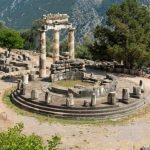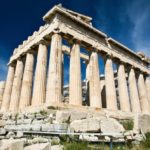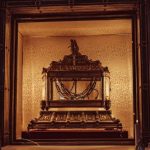 Our World
Our World  Our World
Our World  Movies and TV
Movies and TV The 10 Coolest Stars to Set Sail on The Love Boat
 History
History 10 Things You Didn’t Know About the American National Anthem
 Technology
Technology Top 10 Everyday Tech Buzzwords That Hide a Darker Past
 Humans
Humans 10 Everyday Human Behaviors That Are Actually Survival Instincts
 Animals
Animals 10 Animals That Humiliated and Harmed Historical Leaders
 History
History 10 Most Influential Protests in Modern History
 Creepy
Creepy 10 More Representations of Death from Myth, Legend, and Folktale
 Technology
Technology 10 Scientific Breakthroughs of 2025 That’ll Change Everything
 Our World
Our World 10 Ways Icelandic Culture Makes Other Countries Look Boring
 Our World
Our World 10 Ways Your Christmas Tree Is More Lit Than You Think
 Movies and TV
Movies and TV The 10 Coolest Stars to Set Sail on The Love Boat
 History
History 10 Things You Didn’t Know About the American National Anthem
Who's Behind Listverse?

Jamie Frater
Head Editor
Jamie founded Listverse due to an insatiable desire to share fascinating, obscure, and bizarre facts. He has been a guest speaker on numerous national radio and television stations and is a five time published author.
More About Us Technology
Technology Top 10 Everyday Tech Buzzwords That Hide a Darker Past
 Humans
Humans 10 Everyday Human Behaviors That Are Actually Survival Instincts
 Animals
Animals 10 Animals That Humiliated and Harmed Historical Leaders
 History
History 10 Most Influential Protests in Modern History
 Creepy
Creepy 10 More Representations of Death from Myth, Legend, and Folktale
 Technology
Technology 10 Scientific Breakthroughs of 2025 That’ll Change Everything
 Our World
Our World 10 Ways Icelandic Culture Makes Other Countries Look Boring
10 Ancient Religious Symbols and Their Meanings
Their forms may be strange to us, yet their messages resonate across time. Many ancient religious symbols have played a significant role in shaping the beliefs and practices of different cultures throughout history. These symbols carry deep meanings and are powerful visual representations of spiritual concepts and religious ideologies.
The next time you come across an odd religious insignia, consider looking deeper into its history and role for believers. Religious symbols are like portals into the belief systems and values of cultures worldwide. While emblems like the cross and Star of David are widely recognized today, many more ancient symbols remain a mystery. We’re exploring ten ancient religious symbols from various traditions along with their meanings.
Related: Top 10 Coolest Folk Symbols from around the World
10 Faravahar: Zoroastrian Winged Symbol of the Soul
One of the oldest religions in the world, Zoroastrianism, uses the iconic Faravahar symbol to represent its theology and values. The figure features a bearded man with wings outspread.
This ancient Persian symbol is thought to portray the human soul or fravashi, displaying the duality of good and evil inclinations. The ring around the figure’s waist represents Zoroastrianism’s key tenet of free will and personal responsibility. The downward arm points to earthly concerns, while the upward arm signifies spiritual aspirations.
By incorporating human, eagle, and angelic features, the Faravahar evokes mankind’s dualistic nature and potential to ascend through positive thoughts, words, and deeds. This timeless icon remains a stirring emblem of Zoroastrianism’s moral code and humanity’s eternal inner conflict between darkness and light.
9 The Ankh: The Key of Life
In ancient Egypt, the ankh symbolized life and immortality. Its unique shape, resembling a cross with a loop at the top, represents the key that unlocks the gates to the afterlife. The ankh was associated with various deities and was often depicted in the hands of gods and pharaohs.
Perhaps one of the most widely recognized hieroglyphic symbols from ancient Egypt, the ankh symbolized eternal life and immortality. In Egyptian iconography, this insignia often appeared in the hands of gods, pharaohs, and commoners alike. Placed strategically in tombs, the ankh symbol provided vitality and sustenance to the deceased as they journeyed to the afterlife.
By symbolizing wisdom and insight, the ankh could also invoke divine favor and royalty. Egyptians placed ankhs in offerings, tombs, and temple rituals to promote prosperity, health, and eternal life. This iconic emblem remains one of the most captivating markers of ancient Egypt’s spiritual beliefs surrounding death and rebirth.
8 Thor’s Hammer: Norse Symbol of Protection and Blessing
Well before Marvel movies depicted Thor wielding it in battle, Mjölnir was an ancient Norse symbol used in Viking ceremonies and artwork for over 2,000 years. Mjölnir represented the famed hammer of Thor, the protector god of Asgard. These pendants offered blessings, consecration, and protection.
In Norse mythology, only those worthy of Thor’s powers could lift and wield the mighty hammer. Vikings wore Thor’s Hammer amulets and even had them engraved on gravestones to invoke the god’s strength and favor. After Christianity came to Scandinavia, wearing a Mjölnir pendant could represent peaceful resistance to conversion.
Today, neo-pagan religions like Asatru that worship Norse gods have revived the symbol’s popularity. To followers, the might of Mjölnir remains a meaningful expression of Norse history, values, and ancestral beliefs.
7 The Pentacle: A Wiccan Symbol
The pentacle, a five-pointed star enclosed in a circle, holds significance in Wiccan and pagan traditions. It’s been used as a mystical symbol for over 8,000 years. It represents the four elements—earth, air, fire, and water—along with the fifth element, spirit. The pentacle serves as a symbol of protection, balance, and the interconnectedness of all things in nature.
Worn as jewelry or placed on Wiccan altars, the pentacle summons divine energies for ritual work. Its circular boundaries provide psychic security to practitioners as they access mystical realms. Whether as a protective amulet or magical tool, this ancient sign continues to guide Wiccans in their metaphysical pursuits.
6 Omphalos Stone: Navel of the World in Greek Mythology
A powerful if obscure artifact, the omphalos stone marked what was considered the center of the universe in ancient Greek mythology. Translated as “navel” in Greek, legend held the omphalos was a sacred stone given to Cronus to swallow instead of Zeus at birth.
Later, it was set at the Delphi temple dedicated to Apollo, marking the spot where he killed the mythical Python. Adorned with a knotted net, the stone came to signify Apollo’s divinity and Delphi’s role as the omphalos or world navel linking the heavens and earth.
By sitting on the omphalos stone while inhaling sacred vapors, the legendary Oracle of Delphi could bridge this divide to see into the future. The omphalos stone remains a curious (if overlooked) emblem of the mythical significance ancient Greeks attached to oracles and Delphi as a point connecting humanity and the divine.
5 Awen: Druidic Emblem Invoking Divine Inspiration
Dating back over 2,500 years, the awen is a lesser-known emblem representing the Druid pursuit of wisdom. It features three rays that signify the balance between male and female forces in nature.
This triskelion design was invoked by ancient Celtic Druids while reciting incantations for divine guidance. The emblem captured their belief in awen—the mystical source of poetic eloquence, insight, and inspiration. In Druidic culture, the awen symbol granted access to heightened creativity and knowledge surrounding the secrets of life. Its rays were thought to invoke divine light to any who understood their deeper meaning.
Today, modern Druid communities still use the awen emblem to evoke the flowing spirit and wisdom of their forefathers. It adorns ritual tools and jewelry as a sign of blessing. This enduring insignia remains a stirring emblem of humanity’s search for meaning and connection with forces beyond our comprehension.
4 Khanda: Sikh Emblem of Spiritual Authority
The khanda is a graphic emblem containing four symbolic Sikh images: circle, double-edged sword, chakkar, and kirpan daggers. Together, they represent the core tenets of Sikhism and the ideals the faith promotes.
The inner circle signifies the oneness of God. The two blades indicate spiritual and temporal balance. The right kirpan stands for spiritual justice, and the left for temporal justice. At the emblem’s center, the chakkar is a defensive spinning weapon embodying infinity and the Sikh commitment to fighting injustice.
Originally designed by Sikh leader Guru Gobind Singh in the 17th century, the khanda decorates Sikh flags and temples as a mark of spiritual authority. Its components illustrate how inner enlightenment requires active engagement to uphold justice externally as well. Wearing or displaying this emblem signifies an individual’s initiation into the Sikh faith.
3 The Eye of Horus: Egyptian Protection
The Eye of Horus is an ancient Egyptian symbol representing protection, healing, and divine power. It is often associated with the god Horus, who symbolizes the sky and has the ability to see everything. The Eye of Horus is believed to ward off evil and provide blessings and prosperity.
Dating back to 3000 BC, legend says the left eye of the falcon god Horus was torn out during a battle with the god Set, then was magically restored. As a result, the Eye became a powerful representation of protection and healing in ancient Egypt. Amulets and commemorative texts featuring the Eye were thought to provide defense against disease or injury in the afterlife. It was also used on bowls and other objects to invoke the restoration brought by the god’s resurrection.
With parts of the symbol representing senses, the Eye of Horus was a link between deities and humanity. Ancient Egyptians believed senses made civilization possible, so protecting them meant preserving society. By honoring this history of the Eye’s protective powers, the symbol lives on in jewelry and mystical texts as a call for safety and well-being.
2 The Triskelion: Celtic Symbol of Life
The triskelion, a triple spiral design, is a prominent Celtic symbol. It embodies the cycles of life, death, and rebirth. It represents the three realms: land, sea, and sky, as well as the three stages of existence: past, present, and future. This symbol is associated with continuous growth, transformation, and the eternal nature of the soul.
Dating back over 3,500 years, the triskelion has three bent legs radiating from a center, and it’s often carved into stone monuments, weapons, and artifacts across Celtic cultures. In fact, modern Celtic revival movements still revere the symbol.
1 The Torii Gate: Japanese Sacred Entrance
The Torii Gate marks the entrance to a sacred Shinto shrine. It’s a traditional Japanese symbol representing the transition from the profane to the sacred realm. Serving both practical and symbolic purposes, they purify and protect shrine grounds from evil influences.
The two vertical pillars connected by a crossbeam signify the separation between the physical and spiritual worlds, inviting worshippers to enter with reverence. More elaborate varieties feature multiple tiers, curved or straight rooflines, and ornate embellishments. But all direct visitors’ attention toward the inner shrine that channels kami, or Shinto spirits.
Torii gates remain iconic landmarks beckoning communion between humans and venerated kami in Japanese culture. Their striking forms create visually captivating thresholds to the spiritual worlds that Shinto devotees have revered through the ages.








